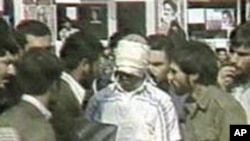November 4 is the 30th anniversary of the siezure, by young Iranian militants, of the U.S. embassy in Tehran. Leading up to that event, the Ayatollah Ruhollah Khomeini had returned to Iran from exile in France, leading an Islamic revolution that forced the Shah of Iran to flee. Fifty-two of the US diplomats seized by the Iranians were held captive for more than a year, most of them at the US embassy.
On November 4, 1979,the United States embassy in Tehran was seized by militants in the name of Iran's new leader, Ayatollah Ruhollah Khomeini. For the next 444 days, it was the scene of captivity for 49 Americans, including embassy Press Attache Barry Rosen.
He describes how he was taken hostage. "One young man, looking rather ferocious at that time, started to kick, to kick the door down," he says, "This person said to me in a loud voice, in Farsi, "You are under arrest! You are a member of the nest of spies! You are going to come with me!"
The Acting US Ambassador at the time, Bruce Laingen, was also taken hostage. In hindsight, he says, the close U.S. relationship with the Shah of Iran, widely unpopular, set the stage for what happened.
"If we had done things differently, you could come up with all kinds of scenarios. But I believe myself that it was almost inevitable," Laingen said.
A celebration in Algiers on November 1st, where Iran's Prime Minister Mehdi Bazargan was photographed meeting with U.S. National Security Advisor Zbigniew Brzezinski, pushed the situation over the edge, according to Victor Tomseth, who was a political officer at the embassy. "I'm convinced to this day that it was that picture that was the catalyst for the student group that carried out the attack on the embassy," Tomseth said.
The U.S. diplomats spent nearly 15 months confined in the embassy, the foreign ministry and other Tehran locations.
In the U.S., Americans hung yellow ribbons to show solidarity, also putting pressure on President Jimmy Carter to act.
Months later, the US mounted a rescue mission. A dust storm turned the operation into a disaster, killing eight servicemen. The mission was aborted.
Barry Rosen says the U.S. made several mistakes, including not closing the embassy after an earlier takeover attempt in February 1979. "We should have shut down the embassy after February 14th. And said to the Iranians 'When you want us back, we will be back,'" he states.
Bruce Laingen says decisionmakers in Washington weren't paying attention to the detailed reports the embassy was providing about the deteriorating situation in Iran.
Washington was paying attention to the Cold War and Moscow, according to Rosen. "We are still worried about the Soviets. We had listening posts in the embassy. That to the administration was more important than bilateral relations or the bodies [the embassy personnel] that were in Tehran," Rosen said.
Bruce Laingen says he spoke with Foreign Minister Ebrahim Yazdi late on November 4 about the situation. "I had a telephone conversation that night, of the first day, when he told me 'Look. We will resolve this by morning.' And I said to him, 'OK, what am I going to do?' What are you going to do with me? And he said 'Why don't you go down into the diplomatic reception rooms [at the Foreign Ministry] and find a place to sleep there?" Laingen recalls.
It was a nap that lasted nearly 15 months. In November 1980, President Carter lost his re-election bid. On January 20, 1981, Ronald Reagan was inaugurated as President of the United States. On the same day, Bruce Laingen and 51 other Americans were freed.
Some 30 years later, the United States and Iran are still at odds.






